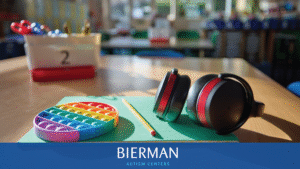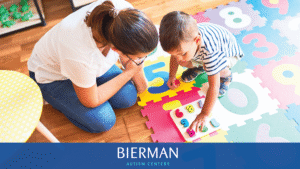You may quickly get lost in the world of acronyms and new lingo when learning more about Applied Behavior Analysis. Today we want to share a list of commonly seen ABA glossary terms, acronyms and definitions. Whether you are a parent, student, technician, or practitioner, we hope you find this list helpful!
Acronyms
ABA Therapy- Applied Behavior Analysis Therapy
EIBI – Early Intensive Behavioral Intervention
People and Collaborators in the field
BCBA – Board Certified Behavior Analyst
BCaBA – Board Certified Assistant Behavior Analyst
RBT – Registered Behavior Technician
SLP – Speech Language Pathologist
OT – Occupational Therapist
PT- Physical Therapist
Communication Terms
AAC – Augmentative and Alternative Communication
PECS – Picture Exchange Communication System
Teaching Arrangements
NET– Natural Environment Training is a teaching model used to support teaching and make learning fun for children and others. The main goal is to embed learning opportunities and teaching into activities that a person enjoys or in everyday routines.
DTT – Discrete Trial Training is a method of teaching used for children and others that may not learn as well in a natural environment. The training includes giving distinct presentations, response expectations and consequences in each learning trial.
FBI- Fluency-based instruction is a teaching model from Precision Teaching that uses time-based trials that increase learning opportunities in shorter periods. When the person meets their aim or goal, it increases the likelihood that fluency has emerged. When fluency is in place, it increases the likelihood that the skill will retain for longer periods of time even if not practiced and be able to be applied in new settings.
Behavior Support
BSP – Behavior Support Plans are function-based written strategy plans designed by clinicians that include individualized proactive and reactive strategies for behavior targeted for decrease. The proactive strategies are preventative manipulations in the environment that decrease the likelihood a behavior might occur, and the reactive strategies are in place for what to do when it does.
ABC – ABC data collection is an assessment tool used to gather the information that supports the determination of the function of a behavior. This information is then used to guide a behavior support plan’s proactive and reactive strategies. ABC refers to:
- Antecedent- Some environmental event or action that occurs immediately before a behavior
- Behavior- The behavior that occurs
- Consequence- Some environmental event or action that occurs immediately following the behavior
Terminology in Behavior Analysis
Derived from Verbal Behavior
Mand – A request.
This could be a request made by speaking, pointing, exchanging a picture, using sign language, etc.
Examples:
- “Drink juice”
- Exchanging an icon for a cookie and then receiving and eating a cookie
- Pointing/reaching for a cracker and, upon receiving it, eating it
Tact – A label.
This could be labeling the name, color, shape, size, smell, category etc., of something. These can also be observed across multiple outputs: speaking, picture exchange or a voice output device.
Examples:
- “I see an airplane,” when walking down the street, and an airplane flies above.
- “I smell popcorn,” as popcorn is being made at the movie theatre
- “There are all the animals!” during a book about the jungle
Listener response (LR) – The response to a receptive direction.
Examples:
- After hearing, “Time to clean up,” the child puts his toy on the shelf
- While reading a book, someone says, “I see the penguin,” and the child points to the picture of the penguin.
Listener response by feature, function, or class (LRFFC) – The response to a receptive direction that includes a feature/function/class.
Examples:
- “Do you see the one with wheels?” when playing with a train track toy (feature)
- “Which one can we eat for a snack?” when opening the refrigerator for a mealtime (function)
- “Where are the 3 animals?” during a book (class).
Echoic – Copying a vocal.
This could be copying a sound, word, sentence, etc.
Example:
- During a book, the teacher says, “The lion says roar,” and the child copies saying, “Roar!”
- Sometimes it will be cued; for example, the technician says, “This is a cat, say, “cat,” and the child says, “cat.”
Imitation – Copying a movement.
This could be a gross or fine motor movement, just 1 action, or a string of actions sequenced together.
Example:
- A peer pushes into his chair, then Johnny pushes into his chair
- If a child copies their peer in a morning routine by hanging up their coat, or backpack and sitting on a carpet square.
- When first learning imitation, it may also be cued with a direction. For example, while singing “the head shoulders knees and toes,” the teacher says, “Try this!” (While touching their knees), Johnny then follows and touches his knees.
Intraverbal – Making a comment, answering a question, or filling in a statement.
These can also be observed across multiple outputs: speaking, picture exchange or a voice output device.
Example:
- A parent says, “I’m running to the store,” and a child responds, “I want to come!”
- During a book about animals, a teacher says, “What does the cat say?” and the student says, “Meow!”
- While singing a song, a parent says, “the itsy bitsy…” and the child says, “spider.”
Visual Performance (VP) or Visual Performance Skills (VPS) – Matching, sorting, or sequencing.
This involves visually putting things that go together or making up patterns.
Example:
- This could be matching identical or nonidentical items/pictures to each other (e.g., dog to dog or shoes to socks)
- Sequencing short stories (3 pictures that go through how to build a snowman)
- Completing a pattern (red block, blue block, red block, and the child puts another red block).
- Puzzles are a great way the emphasize these learning opportunities and grow as skills are learned (inset puzzles, jigsaw, and so on)
Textual – Reading text.
This does not necessarily mean that the child understands what it is they are reading.
Example:
- A child reads a page in a book
- The student reads their name written on the chalk
- While driving and seeing a stop sign, the child reads the sign and says, “stop!”
Transcription – Writing or spelling what is spoken or heard.
Example:
- During a spelling test, the teacher says “cat,” and the child writes cat.
- This could also be cued with a direction: The teacher says, “Write ‘blue.'” The student writes blue.
Reinforcement – A consequence immediately following a behavior that increases or maintains the number of times that behavior may occur.
Reinforcement is not always a ‘positive’ consequence, you may accidentally reinforce a behavior with an intended consequence if the behavior is maintained by that function.
Examples:
- The child says, “cookie,” and you give them a cookie. When they walk into the kitchen, they frequently say, “cookie.”
- The child bites their parent, and the parent says, “you stop that right now.” Now when the child experiences a deprivation in their parent’s attention, they bite them. (a “not positive” example)
- When asked to get dressed in the morning, a child screams until 5 minutes before leaving, so the caretaker dresses them. Now, when asked to get dressed, the child screams until the caretaker dresses them.
Pairing– We use pairing to refer to pairing a person or toy with reinforcement to help build rapport and potentially expand the list of preferred people and things for the child.
Examples:
- A behavior technician acts silly, makes activities better and provides physical and gross motor play opportunities to pair themselves with fun and stimulating activities.
- Following the child stacking blocks, the behavior technician hands the child a car and makes a crash sound when the child knocks the blocks over. This pairs the act of “building blocks” with fun and silly effects.
Bierman Autism Centers is a place where kids as young as 18 months to 9 years of age engage in play to learn foundational skills they can build on, such as self-advocacy and communication. They recognize that every kid’s success is unique, and their one-on-one approach allows them to drive progress, and measurable outcomes, while each child is advancing on their own terms.
With over 200 graduations, Bierman currently has centers and is expanding in: Arizona, Indiana, Massachusetts, North Carolina, New Jersey, Ohio, and Rhode Island. For more about Bierman Autism Centers, visit www.biermanautism.com or call 800-931-8113.


